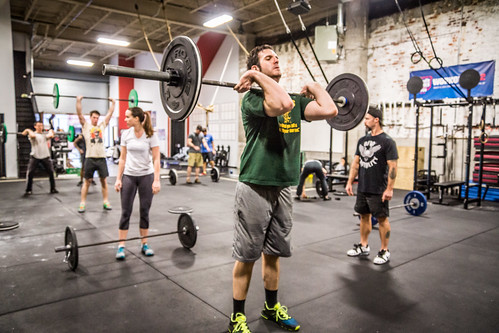CrossFit Group Class Coaching Expectations: How to Work with Another Coach
 Monday, June 30, 2014 at 12:00AM
Monday, June 30, 2014 at 12:00AM 
Growing up, I hated team sports. I didn’t like being responsible for the outcomes of other peoples’ experiences, and I didn’t like other people being responsible for mine. This disposition was part of why I wanted to become a coach, have my own business, and do it without partners. I loved that every class and aspect of the gym came out of my own expectations and intuitions. But as our gym got bigger, one of the skills I had to acquire was being a better team player. Most CrossFit coaches have pretty strong personalities, which can lead to wanting to control everything—especially when it comes to running a group class. Working with people isn’t always intuitive, and requires practice and clear expectations about each person’s role.
Continuing on in ITA’s series about CrossFit group class coaching expectations, I’ve outlined basic guidelines that allow my coaches to focus on working as a team, and not be sidetracked by logistics while running classes. There aren’t assistant coaches or interns at CFSBK, and everyone has an equal share of work. We ensure that there is transparency and balance between who does what, which goes a long way in avoiding disputes or ambiguity regarding roles and duties. This also provides good guidelines for feedback if there is an imbalance in how coaches are working a class together.
Below are four basic principles that ensure our coaches will work as a team.
 1. Coaches should discuss work distribution before class starts, trying to keep overall workload even.
1. Coaches should discuss work distribution before class starts, trying to keep overall workload even.
Figure out before class which coach will take the lead on any segment, especially ones that require led group instruction. If the class needs to be split up between programming levels, then decide together which coach will be responsible for which group.
Your affiliate may be different and have "head" and "assistant" coaches, or perhaps interns. Another exception would be when a new coach comes on, since at first, they should probably be assigned fewer or less demanding roles before moving up to a normal distribution. Whatever the case may be, having clear guidelines set ahead of time both ensures people understand their roles and creates transparency and communication about what needs to get done and who will get it done.
2. While one coach is leading flow, the second coach should be organizing logistics for the following segment or working with troubled movers.
If a segment requires a coach to lead the group through drills, the second coach should be walking the room making corrections, especially with more troubled or newer members. This way the coach leading the drills can continue working with the class as a whole while the second coach micromanages athletes and issues that come up along the way. Sometimes, this involves simple cues and adjustments; other times, this might mean pulling the athlete aside to discuss or correct an issue. The goal is to help the people who need it without disrupting the flow of the progression and class.
 3. Evenly distribute athletes between coaches.
3. Evenly distribute athletes between coaches.
Especially during lifting segments, coaches should decide which groups of athletes they'll be working with, attempting to split the class up as evenly as possible. We like this method because the coaches get to work with a smaller relative number of athletes and can provide more consistent feedback to their group. This isn’t some laborious and embarrassing process of picking teams; it’s simply scanning the room and making decisions that enable a more effective coaching situation. At CFSBK, maybe we’ll see that there are nine active squat racks with two to four people per rack, so one coach will take five racks while the other will take four.
In particularly large classes, we'll also announce to the athletes who their "platform coach" will be for that segment so they can come to them if they have a pressing question. Of course, if a coach sees something that needs addressing in someone not in their group they'll pick it up or tell the other coach. The point is not to put the blinders on to half the class, but to better manage people and work distribution.
 4. If a class goes over, one coach should finish out that class while the other coach begins the next class.
4. If a class goes over, one coach should finish out that class while the other coach begins the next class.
This is relatively straightforward and something we discussed in our timeliness article. Basically, during transitions, the coaches should plan ahead as to how they'll manage space and athletes if it looks like class might run over. Our goal at CFSBK is to start every class on time, no matter what, so this might take some ingenuity from the coaches based on the available footprint and resources. But again, basic communication will lead to running a tight ship and better leveraging your two coaches so that athletes don't have to wait around and miss valuable warm-up and training time.
Coaching with another person is all about playing nice with others to ensure your athletes have the best experience possible in group classes. But working as part of a well-functioning team also means you’ll have a better experience as a coach.

Reader Comments (1)
nice article